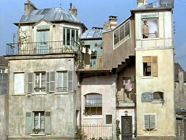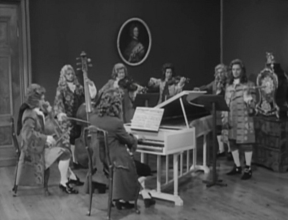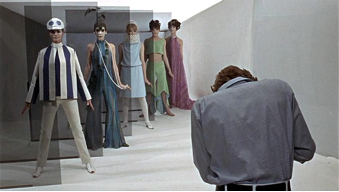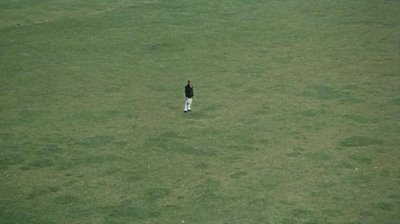In its multiple forms, the cinema offers opportunities for an encounter. Unlike the act of viewing, encountering rejects passivity and engages; it brings two together: the self and the other, the camera and the world, the audience and the film. Cinema allows us to document, revisit and transform these encounters. More than an experience, it’s a space for one to connect with the many. As apparent as it seems, this conception of filmmaking and film watching stands outside the present dominating film culture, which views the self and society as already fulfilled, and therefore without a necessity for the other. Films are made with a “target” audience in mind; viewers accept their part as such audience and expect their sensibilities to be stroked; and what they learn from the experience are lessons that they already know and agree with. What results from this mode of thinking is the reinforcement of a pre-conceived, ideal self (both the filmmaker’s and the viewer’s), and the disappearance of the other as necessary.
While this view isn’t exclusive to the “film world” and leads to other detrimental social consequences, when applied to the way we write and think about the cinema, we undermine its power and possibilities. We end up reducing the films and ourselves to notions of taste, likes, and dislikes. The essays that follow attempt to bring back to life my encounters with these films, to retrace and verbalise insights triggered by their elusive nature, and to assimilate those insights into my understanding of film and enhance my relationship to others. These aren’t attempts to legitimise the work of Jacques Tati, Jean-Marie Straub and Danièle Huillet, or Michelangelo Antonioni (filmmakers who do not need more legitimising), but to find in their radically different approaches to cinematic form, this conception of the cinema as a space marked with multiple opportunities. Finally, they remind us that the different ways we experience their work show us different forms of engagement, and that there is no “film world” but only our world to encounter.
Mon Oncle: The Ritual of Order, the Comedy of Mess
Formal arrangements spring out of a reaction to chaos. Not just in art (in the classical sense), but also in the way men and women rearrange their surroundings and their habits. This rearrangement happens both in space (a house, a neighborhood, a city) and time (the daily ritual, the patterns of behavior, the reoccurrence of events). In Mon Oncle (1958), Jacques Tati recreates this attempt at reordering our surroundings and shows us what a fine line divides order from chaos. There are three settings where we become accustomed to the order in place: the family’s hi-tech and modern residence, Hulot’s neighborhood, and the hose factory. Each one displays different forms of rearrangements and how those forms are experienced in time. These environments showcase their own order and the different, sometimes meticulous, rituals that maintain it. Any break or disruption causes an involuntary rearrangement of their surroundings and that results in chaos and comedy.
Tati’s comic gags are observed from afar and over a long period of time. His characters are not simply defined by their motivations and obstacles, but almost entirely by how they fit in and interact with their environment. The inner experience of people is not limited to their bodies, feelings and ideas. In fact, Tati reduces dialogue to a minimum, impeding the audience from developing an idea of characters from what they have to say, and how they express their desires. The soundtrack of the film mostly focuses on environmental sounds, and of the noises people add to the location (footsteps, whistles, laughter). Even when the characters speak, their tone and inflection has greater importance than what they actually say. These are not environmental clues that offer us characterisation, but rather it is environment as character and vice versa. Therefore, when an upper class woman solely identifies herself with her modern, symmetrical house, a disruption of that space becomes a disruption of her identity.
The modern household of Hulot’s brother-in-law is where this identification with the external is most pronounced; therefore it is the central focus of satire in the film. The husband and wife make sure the house’s plants are well trimmed, the dust is cleaned, and that the fountain at the garden is always running when visitors drop by. When visitors come, they usually exchange pleasantries in the most overtly polite (almost grotesque) tone, reaffirming the necessity for maintaining the created order. The house is symmetric, the garden geometric, the dog’s clothes always matches that of the master, and it all follows a strikingly crafted color palate. Equipped with futuristic gadgets, such as a stove that flips the meat for you, nothing in the house would ever “naturally occur”. Instead, the house is a modern manifestation of a space crafted by man’s thinking and whatever defines the people who inhabit it. But such formal precision is even more vulnerable to the imprecision of others. When the couple hosts an afternoon get-together, they find their house open to disaster. Their attempts at making their guests follow through with the careful rituals that maintain an arbitrary social and spatial order, in time end up building complications that cause an orderly chaos to the embarrassment of the hosts. We could say that Hulot causes the mess, but we would fail to notice that he is simply acting accordingly with the environments and patterns he is used to, just like everyone else that attends the party (one of the guests dresses and behaves like Marilyn Monroe, embodying the process identification with an external form). This same involuntary failure to adhere to the rituals that maintain order leads to the malfunction at the hose factory that makes the plastic tubes look like sausage strips like “in a delicatessen”.
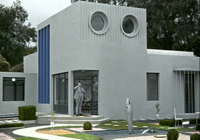
Different arrangements of space in Mon Oncle.
Monsieur Hulot’s neighborhood provides an interesting counterpoint. Compared to the modern residence, the neighborhood seems like a chaotic place. The streets are crowded, people argue with vendors, dogs roam around, and children play pranks on adults. Yet, over time, we realise that the mess actually follows a kind of pattern, and that these disruptive situations are assimilated into the order of the environment. Throughout the film, we see a sweeper who, as he’s about to sweep a pile of garbage, he gets distracted by an argument and never does his job, the pile getting bigger as the film goes on. While the pile of dirt may appear as an indication of disorder and chaos (certainly, when juxtaposed to the aseptic house of Hulot’s brother-in-law) the fact that the sweeper repeatedly intends to clean it but never does suggests a kind of order in the life of the neighborhood. Hulot lives on the top floor of a crowded building, and to get to his apartment he has to walk in and out of the apartments of others, in a sort of labyrinthine journey to his place. Yet Hulot repeats this process effortlessly as he genuinely greets his neighbors along the way, as though in a seemingly chaotic arrangement, Hulot behaves at ease. This neighborhood comes to reflect Tati’s own worldview, which even in the sequence of the disastrous get-together manages to create a sort of orderly chaos (the cinema being, after all, a formal rearrangement of time and space). However, we notice that the neighborhood is being demolished, and would soon be replaced by the modern architecture that plagues Playtime (1967). Mon Oncle is Tati’s documentation of a worldview disappearing, but always in comedy, and always life affirming.
The Chronicle of Anna Magdalena Bach: Performing the Image
The opening shot of The Chronicle of Anna Magdalena Bach (1968) shows the back of a man playing the harpsichord and his hands tightly framed as he plays a virtuosic piece. This man, we assume (and later confirm) is Johann Sebastian Bach, or more accurately, Gustav Leonhardt as Bach. The shot goes on for a few minutes before the camera drastically pulls back revealing the rest of the space and a string quintet who just at that moment join in the performance of the piece. Bach’s music is one of multiple variations, melodic, harmonic, rhythmic. There is, within strict and complex formal arrangements, an immense freedom given to the listener as to what to “follow”. Yet, this act of following the music is complicated by breaks in the patterns, tonal changes and rhythmic alterations that create a sense of release from the expected—what we’ve gotten used to over time as the piece has been played—and that demands a present-mindedness on the part of the listener to really listen each moment. Jean-Marie Straub and Danièle Huillet’s film also consists of stylistic decisions that insist on moment-to-moment awareness. The opening shot opens up to a larger space, adding elements that match the musical piece performed. Throughout the performances shown in the film, reframing is used repeatedly, but with variations in how it relates to the music and the previous camera movements. What results is a minimally complex way in which to show performed music, music that belongs to the past as much as it does to the present.
Opening shot of The Chronicle of Anna Magdalena Bach.
Gustav Leonhard was a pioneer of the period instrument revivalist movement that started in the 1960s. To really listen to classical music, one had to hear it from the instrument it was intended to, as antiquated and hard to find as they were. In his performances, he was showing an audience of all ages, familiar music like they hadn’t heard it before because it belonged to a past unheard. This provided a link to the past that was brought to life in a present performance. This act finds a parallel in the cinema, which provides a link to the past when the film screens. But this turn to the past in order to “really see” or “really listen” is marked by contradictions, limitations, and subjectivity. Ultimately what we hear is Leonhardt’s interpretation of Bach and it is only as accurate as he approaches it, based on a series of judgment calls made on his part. All attempts at recreating the 1700s in the film are also seen as approaches to accurateness, in the costuming, in the use of locations, and even in the casting of Leonhardt. Yet these approximations in a narrative structure consisting mostly on the performance of musical pieces are seen more as decoration, or elements added to a performance than as a means to embody the past. This disconnect between the piece attempted and attempting the piece is present in any interpretation of music when performed, just as in the cinema there’s a disconnect in the event recreated and in recreating the event. So the filmmaking that goes on in The Chronicle of Anna Magdalena Bach has more in common with musical interpretation than with biographical recreation. For it is in that moment where performance becomes performing that complexity, engagement and a truthful act occurs. We no longer see an act, as we expect it to be, but we see an action happen over time.
So when the frame changes, we notice it. How it changes varies. Sometimes the reframing reveals more space and people, as in the opening shot. Other times, it closes in on a performer, highlighting them while we listen to the rest of the ensemble continue on off-screen, as in the scene where they rehearse a cantata. During the cantata’s prelude, the camera shows the entire orchestra, but as it pushes in to the singer it ends with him, Leonhardt and a few other musicians in a cluttered frame. Up close, we see their faces, and the minute, involuntary gestures that arise out of the musical performance: small jerks of the head, deep breathing, and a rhythmic movement that blends their bodies with the music. This camera movement not only brings into focus certain elements (and highlights the presence of what is left off-screen but we keep listening) but it’s a movement from musical performance into musical performing, bringing to our attention details that go on as music is played. A similar shift happens in a scene where Bach/Leonhardt plays the Goldberg variations just as he finished writing them. The frame begins with his hands and slowly glides toward his face, his hands (playing), and then his eyes constantly shifting their attention from keyboard to music sheet, displaying the loop between music and playing—what we hear and the mental, physical process that occurs to make it happen.
Caption: Leonhard and ensemble perform Bach’s Cantata BWV 205.
Sometimes the camera does not move, maintaining the same frame throughout entire performances at a time, keeping us attentive for any change that may occur in the frame, and ultimately letting the image be performed as it may. A brilliant occasion happens near the end of the film: we see in the sky framed through trees as Bach’s music plays in the soundtrack. The disconnection between sound and image, the greatest gap among all gaps in the film, create a sense of the sublime. This is not simply an image that was “captured” but it is rather an image being played like music is played. What Jean-Marie Straub and Danièle Huillet do is simple and exhilarating. They create the present, under the pretense of recreating the past.
Blow-Up: An Essay
To write about Michelangelo Antonioni’s Blow-Up (1966) involves certain complications. How is one assertive and secure about a film where uncertainty is everywhere? Blow-Up is as much about its subject as it is about the act of watching it and, in the process, seeing that subject mutate into multiples. Antonioni achieves this not by means of a zigzagging narrative but instead by representing its figures in ways that allow such multiplicity without falling into mere abstractions. The film depends as much about the viewer’s perception and the relationship that forms between them. The tendency to interpret and assign meaning to our surroundings come into question in this film, and therefore new interpretations arise and crumble when confronted with Antonioni’s ever shifting images. With the advantages of today’s technology, we might feel compelled to pause the film at any given moment and, with detail, examine the image in order to figure out what they mean, what they’re really saying. But to do that will only make us just as confused as the photographer in the film who, as he scrutinises his photographs of a couple in a park, the difference between what he sees and what he wants to see dissolves. So then the question arises: how does one write about Antonioni’s Blow-Up?
I could say something like: Antonioni’s keen awareness of the fact that what is captured in film is simply the surface of its subjects, allows him to move beyond the pretense of capturing the “essence” of the narrative or characters. Instead, the characters and narrative exist in order for Antonioni to capture their surfaces and then explore the formal possibilities of the film medium to make those surfaces slippery, mutable. The film opens with a gang of mimes raging mayhem on a London street. The group, first on a jeep drives around in circles outside a building, a scene cut in a way in which continuity from shot to shot is disrupted, and the direction they’re moving changes with each shot. Eventually, they jump off the jeep and run down the street screaming unintelligibly. As they run, one of the mimes, a girl, stops and looks back and an eye-line match cut of the photographer exiting a prison miles away from the mimes gives the appearance that she was looking at him. The editing of the opening demonstrates one way in which Antonioni transforms his images, either by disrupting the spatial and time continuity of an event happening in one location (the jeep driving around in circles) or by revealing a continuous match-cut to be a disruption of space and time (the eye-line match of the mime and photographer). What we are left with are images, surfaces, constantly changing on-screen by means of editorial manipulation or revealed to be psychological constructs in the viewer’s mind. Montage in here is both revealed to be an illusion fed by a psychological need to bridge gaps, and a subversion of that illusion, making the gap wider each time two images are brought together. This is further illustrated in the scene when the photographer makes the final blow-up (of what apparently is a body lying on the floor). When first shown, a non-figurative image appears, just splotches of large black and white dots. Then, the camera looks up at the other picture from which this blow-up is made from and the comparison between the two images suggests that the splotches are a dead body. One image transformed by the other, yet casting doubt as to what each image embodies on its own.
Caption: Shifting surfaces in Blow-Up.
I could also say something like: Antonioni’s awareness of surfaces invades the film throughout. For example, its use of bright colors accentuates the surface of objects, clothes, cars, and nature. Color in the film is not treated as a symbolic strategy, a practice that is very common among other filmmakers, to point out abstract concepts that help a narrative such as “evil,” “danger,” “benevolence.” Nor is it used to add “realism” to the image, since we rarely find colors to be so vibrant in life as they are in the film. Yet color reaffirms the presence of someone or something, or more specifically, the presence of their surface (interestingly, color is absent from the photographs the main character takes). The framing of the shots, catching a reflection whenever possible, or constantly reestablishing the spatial relation to the subjects, reinforce the two-dimensionality of the image and how it molds and transform the figures it “represents.” Not only in form but also in content this preoccupation with the exterior becomes apparent, setting the narrative within the 1960s Mod subculture of England, which indulged in how people “presented” themselves through fashion and the sex-appeal of being photographed. And if it weren’t enough, all of it is presented in grainy cinematography, which highlights the surface and materiality of the film itself.
Or I could say something like this: Writing about Blow-Up feels like a futile activity. The insecurity one goes through while watching the film is its greatest achievement; it is an insecurity that sparks curiosity and an attention to detail. The bewilderment it creates cannot be reduced down to words, because it resists any type of decoding while falsely seeming exactly like a film that requires interpretation and explaining. What we are left with is a twisted relationship formed between us and an image that changes twenty-four times a second, until it ends with us looking down at an empty, green field.


